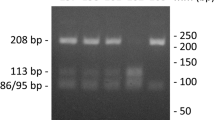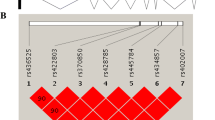Abstract
Aim
To evaluate whether the presence of specific polymorphism in the gene promoter of collagen and some matrix metalloproteinases was associated with the risk of developing pelvic organ prolapse.
Methods
A case–control study was carried on 233 women: 137 were cases with ≥stage II pelvic organ prolapse and 96 were matched controls without pelvic pathologies. Allele and genotype frequencies related to polymorphisms at the Sp1 site of type I collagen and some functional polymorphisms in the promoters of metalloproteinases-1, -3 and -9 have been compared between groups. It has been shown that these single-insertions/deletions polymorphisms located in the promoter region of the genes have a functional significance in the regulation of their transcriptional level and local expression. Genotypes were determined by polymerase chain reaction (PCR) amplification and sequence analysis. SPSS 14.0 software was used for data analysis. Probability values of <0.05 were considered statistically significant.
Results
No difference between groups was found in the genotype distribution polymorphisms for COL1A1, metalloproteinases-9 and -3, while the distribution of the polymorphism of metalloproteinases-1 was significantly increased in the cases when compared with controls (p = 0.04).
Conclusions
Our findings suggest that the polymorphism of metalloproteinases-1 might have a role in mediating susceptibility to pelvic organ prolapse.
Similar content being viewed by others
References
Olsen AL, Smith VJ, Bergstrom JO, Colling JC, Clark AL (1997) Epidemiology of surgically managed pelvic organ prolapse and urinary incontinence. Obstet Gynecol 89:501–506
Brown JS, Waetjen LE, Subak LL, Thom DH, Van den Eeden S, Vittinghoff E (2002) Pelvic organ prolapse surgery in the United States. Am J Obstet Gynecol 186:712–716
Kim CM, Jeon MJ, Chung DJ, Kim SK, Kim JW, Ba SW (2007) Risk factors for pelvic organ prolapse. Int J Gynecol Obstet 98:248–251
Nygaard I, Bradley C, Brandt D (2004) Pelvic organ prolapse in older women: prevalence and risk factors. Obstet Gynecol 104:489–497
Chiaffarino F, Chatenoud L, Dindelli M, Meschia M, Buonaguidi A, Amicarelli F et al (1999) Reproductive factors, family history, occupation and risk of urogenital prolapse. Eur J Obstet Gynecol and Reprod Biol 82:63–67
Carley ME, Schaffer J (2000) Urinary incontinence and pelvic organ prolapse in women with Marfan or Ehlers–Danlos syndrome. Am J Obstet Gynecol 182:1021–1023
Gabriel B, Watermann D, Hancke K, Gitsch G, Werner M, Tempfer C et al (2006) Increased expression of matrix metalloproteinase 2 in uterosacral ligaments is associated with pelvic organ prolapse. Int Urogynecol 17:478–482
Vulic M, Strinic T, Bukovic D, Tomic S, Zupic T, Pavic M et al (2010) Expression of matrix metalloproiteinase-1 in uterosacral ligaments tissue of women with genital prolapse. Coll Antropol 34:1411–1414
Dviri M, Leron E, Dreiher J, Mazor M, Shaco-Levy R (2011) Increased matrix metalloproteinases-1,-9 in the uterosacral ligaments and vaginal tissue from women with pelvic organ prolapse. Eur J Obstet Gynecol Reprod Biol 156:113–117
Strittmatter WJ, Roses AD (1995) Apolipoprotein E and Alzheimer disease. Proc Natl Acad Sci 92:4725–4727
Dunleavey L, Beyzade S, Ye S (2000) Rapid genetype analysis of the matrix metalloproteinases 1 gene 1G/2G polymorphism that is associated with risk of cancer. Matrix Biol 19:175–177
Ye S, Watts GF, Mandalia S, Humphries SE, Henney AM (1995) Preliminary report: genetic variation in the human stromelysin promoter is associated with progression of coronary aterosclerosis. Br Heart J 73:209–215
Yamada Y, Ando F, Niino N, Shimokata H (2004) Association af a polymorphism of the matrix-metaloproteinase-9 gene with bone mineral density in Japanese women. Metab Clin Ex 53:135–137
Bump RC, Mattiasson A, Bo K, Brubaker L, DeLancey JOL, Klarskov P et al (1996) The standardization of terminology of female pelvic organ prolapse and pelvic floor dysfunction. Am J Obstet Gynecol 175:10–17
Vinkanharju A, Melkko T, Risteli J, Risteli L (2001) New PCR-based method for the Sp1 site polymorphism in the COL1A1 gene. Clin Chem Lab Med 39:624–636
Minematsu N, Nakamura H, Tateno H, Nakajima T, Yamaguchi K (2001) Genetic polymorphism in matrix metalloproteinase-9 and pulmonary emphysema. Biochem Biophys Res Commun 289:116–119
Biondi ML, Ghilardi G, Mangoni J, Scorza R, Leviti S, Guagnellini E (2001) Matrix metalloproteinase-1 promoter polymorphism 1G/2G is correlated with colorectal cancer invasiveness. Clin Canc Res 7:2344–2346
Szyllo K, Smolarz H, Makowska H, Niewiadornski M, Kozlowska E, Kulig A (2002) The promoter polymorphism of the matrix metalloproteinase 3 [MMP-3] gene in women with ovarian cancer. Exp Clin Cancer Res 21:357–362
Luber KM, Boero S, Choe JY (2001) The demographics of pelvic floor disorders: current observations and future projections. Am J Obstet Gynecol 184:1496–1503
Tegerstedt G, Miedel A, Maehle-Schmidt M, Nyrén O, Hammarström M (2006) Obstetric risk factors for symptomatic prolapse: a population-based approach. Am J Obstet Gynecol 194:75–81
Jack GS, Nikolova G, Vilain E, Raz S, Rodríguez LV (2006) Familiar transmission of genitovaginal prolapses. Int Urogynecol J 17:498–501
Campeau L, Gorbachinsky I, Badlani GH, Andersson KE (2011) Pelvic floor disorders: linking genetic risk factors to biochemical changes. BJU Int 108:1240–1247
Gabriel B, Denschlag D, Göbel H, Fittkow C, Werner M, Gitsch G et al (2005) Uterosacral ligament in postmenopausal women with or without pelvic organ prolapse. Int Urogynecol J 16:475–479
Ewies AA, Al-Azzawi F, Thompson J (2003) Changes in extracellular matrix proteins in the cardinal ligaments of postmenopausal women with or without prolapse: a computerized immunohistomorphometric analysis. Hum Reprod 18:2189–2195
Barbiero EC, Sartori MG, Girão MJ, Baracat EC, de Lima GR (2003) Analysis of type I collagen in the parametrium of women with and without uterine prolapse, according to hormonal status. Int Urogynecol J 14:331–334
Cho H, Jung H, Kim S, Choi J, Cho N, Bai S (2009) Polymorphism of COLIA1 gene Sp1 binding site in Korean women with pelvic organ prolapse. Yonsei Med J 50:564–568
Woessner JF Jr (1994) The family of matrix metalloproteinases. Ann N Y Acad Sci 732:11–21
Hojilla CV, Mohammed FF, Khokha R (2003) Matrix metallproteinases and their tissue inhibitors direct cell fate during cancer development. Br J Cancer 89:1817–1821
Chen BH, Wen Y, Li H, Polan ML (2002) Collagen metabolism and turnover in women with stress urinary incontinence and pelvic prolapse. Int Urogynecol J 13:80–88
Jackson SR, Avery NC, Tarlton JF, Eckford SD, Abrams P, Bailey AJ (1996) Changes in the metabolism of collagen in genitourinary prolapse. Lancet 347:1658–1661
Chen HY, Lin WY, Chen YH, Chen WC, Tsai FJ, Tsai CH (2010) Matrix metalloproteinase-9 polymorphism and risk of pelvic organ prolapse in Taiwanese women. Eur J Obstet Gynecol Reprod Biol 149:222–224
Skorupski P, Miotła P, Jankiewicz K, Rechberger T (2010) MMP-1 and MMP-3 gene encoding polymorphism and the risk of the development of pelvic organ prolapse and stress urinary incontinence. Ginekol Pol 81:594–599
Conflict of interest
The authors have no financial, personal, political, intellectual or religious interests to disclose.
Author information
Authors and Affiliations
Corresponding author
Rights and permissions
About this article
Cite this article
Ferrari, M.M., Rossi, G., Biondi, M.L. et al. Type I collagen and matrix metalloproteinase 1, 3 and 9 gene polymorphisms in the predisposition to pelvic organ prolapse. Arch Gynecol Obstet 285, 1581–1586 (2012). https://doi.org/10.1007/s00404-011-2199-9
Received:
Accepted:
Published:
Issue Date:
DOI: https://doi.org/10.1007/s00404-011-2199-9




